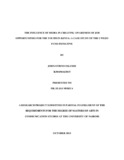| dc.description.abstract | Youth unemployment is one of the most pressing socio-economic problems facing most developing countries. The Government of Kenya has been improving efforts aimed at increasing employment opportunities for young people. Despite increased media space and emergence of new media platforms, media use among the Kenyan youth has largely been for social interaction and thus has not been adequately leveraged as a powerful tool for creating awareness and encouraging youth participation in job creation initiatives. This study used Uwezo fund initiative as an illustrative case to determine how the media could influence the youth to participate in the fund; find out the type of media platforms used by the youth to access information on the fund; determine media literacy skills required by the youth to access and use information from the media; and highlight the challenges faced by the youth in accessing and using information on the fund. Using McCombs and Shaw (1972), Agenda Setting Theory as a theoretical framework, the study employed a descriptive research design, using a mixed method approach to examine the interaction between the media and youth within the context of the Uwezo Fund initiative in Kisumu County in Kenya. The study found out that the influence of media on youth participation in job creation is overrated as evidenced by a significant proportion of youth who were not persuaded by the media to participate in the fund and a significant proportion of others indicating that they obtained information on the fund from other sources apart from the media. It also established that perhaps radio as a media platform would provide better returns owing to a strong preference for information broadcasted through radio by the youth. Lastly, the study found out that the youth face significant challenges in accessing and engaging the media and these challenges included complex messaging, prohibitive costs, internet inaccessibility, and inadequate of media literacy skills. This study therefore recommends that Uwezo Fund administrators should develop contextualized simple messages that resonate with the youth for creating awareness of the fund in various regions; reorganize their outreach strategy to target youth who from the study appeared less involved in the funds activities; bridge gender disparities by encouraging more participation of women in the funds initiatives; leverage potential of radios for creating awareness of the fund; and also scholars can further embark on exploring why the level of influence of media in creating awareness of the fund is limited as exhibited by this study and how can it be improved. The study concludes that media has a significant potential to influence the youth to engage in job creation, however, its engagement with the youth should endeavor to go beyond conveyance of information to deeper discourse. | en_US |

